The Brazos Review: AMD's E-350 Supplants ION for mini-ITX
by Anand Lal Shimpi on January 27, 2011 6:08 PM ESTAMD has been curiously absent from the value netbook and nettop segments since Atom’s arrival nearly three years ago. These markets are highly profitable only for component vendors, as the OEMs that sell netbooks and nettops must survive on very slim margins in order to hit aggressive price points. It wasn’t too long ago that we were shocked by $699 desktop PCs, but to now be able to get a fully functioning portable PC with display at below $300 is impressive. In order for the profit equation to work out however, you can’t simply scale down a larger chip - you need an architecture targeted specifically at the type of very light workloads you expect to encounter in these segments. Underclocking and undervolting an architecture targeted at high end desktops or servers won’t cut it.
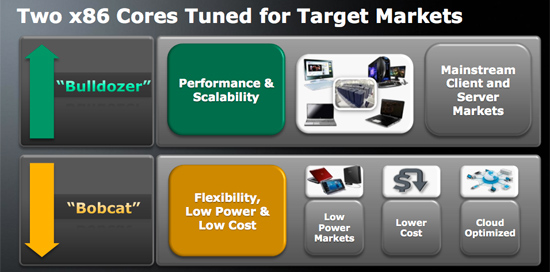
Generally a single microprocessor architecture can cover an order of magnitude of power envelopes. You can take an architecture from 10W - 100W using clock speed, voltage scaling and disabling features (e.g. cutting cache sizes). You can’t efficiently take a 100W architecture and scale it down to 1W. Intel realized this with Atom, and what resulted was a new architecture designed to span the 0.5W - 5W range. Given the constraints of the process (Atom was built at 45nm) and a desire to keep die size down to a minimum (and thus maximize profits), Intel went with a dual-issue in-order architecture reminiscent of the old Pentium - but with a modern twist.
AMD came to the same realization. For it to compete in these value markets, AMD couldn’t rely on its existing Phenom II derived architectures. The Phenom II and its relatives currently span a range of TDPs from 9W to 140W, and at the lower end of that spectrum we’re talking about some very low clock speeds and performance targets. Getting down to 1W was out of the question without a separate design.
What AMD came up with was a core called Bobcat, initially targeted for netbooks, notebooks, nettops and entry level desktops. Architecturally Bobcat is a significant step ahead of Atom: while still dual-issue, it features an out-of-order execution engine making it the Pentium Pro to Atom’s Pentium.
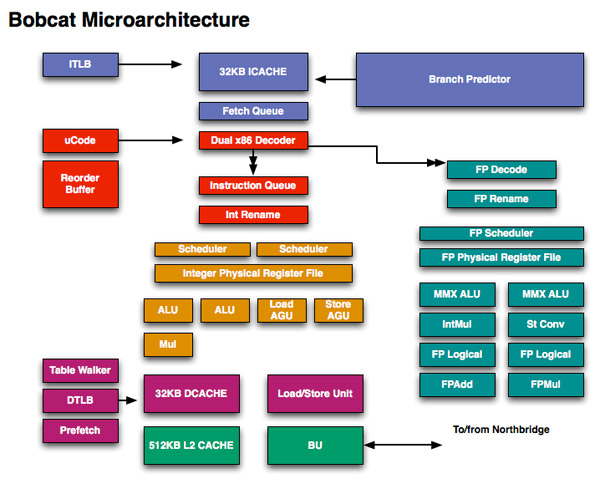
It isn’t just CPU architecture that AMD surpassed Atom with, the first incarnation of Bobcat is an integrated SoC with on-die DirectX 11 GPU. AMD calls this combination a Fusion APU (Accelerated Processing Unit) as it places both a CPU and GPU on a single die. The possible CPU/GPU combinations for Bobcat based APUs are listed in the table below:
| AMD Brazos Lineup | ||||||||
| APU Model | Number of Bobcat Cores | CPU Clock Speed | GPU | Number of GPU Cores | GPU Clock Speed | TDP | ||
| AMD E-350 | 2 | 1.6GHz | Radeon HD 6310 | 80 | 500MHz | 18W | ||
| AMD E-240 | 1 | 1.5GHz | Radeon HD 6310 | 80 | 500MHz | 18W | ||
| AMD C-50 | 2 | 1.0GHz | Radeon HD 6250 | 80 | 280MHz | 9W | ||
| AMD C-30 | 1 | 1.2GHz | Radeon HD 6250 | 80 | 280MHz | 9W | ||
AMD avoided branding its first APUs, they’re simply the AMD E-series and C-series Fusion APUs. The emphasis isn’t on the CPU or the GPU in this case, just the company name and a model number.
| CPU Specification Comparison | ||||||||
| CPU | Manufacturing Process | Cores | Transistor Count | Die Size | ||||
| AMD Zacate | 40nm | 2 | ? | 75 mm2 | ||||
| AMD Thuban 6C | 45nm | 6 | 904M | 346mm2 | ||||
| AMD Deneb 4C | 45nm | 4 | 758M | 258mm2 | ||||
| Intel Gulftown 6C | 32nm | 6 | 1.17B | 240mm2 | ||||
| Intel Nehalem/Bloomfield 4C | 45nm | 4 | 731M | 263mm2 | ||||
| Intel Sandy Bridge 4C | 32nm | 4 | 995M | 216mm2 | ||||
| Intel Lynnfield 4C | 45nm | 4 | 774M | 296mm2 | ||||
| Intel Clarkdale 2C | 32nm | 2 | 384M | 81mm2 | ||||
| Intel Sandy Bridge 2C (GT1) | 32nm | 2 | 504M | 131mm2 | ||||
| Intel Sandy Bridge 2C (GT2) | 32nm | 2 | 624M | 149mm2 | ||||
These APUs do need the aid of an additional chip - the Hudson Fusion Controller Hub (FCH). The FCH adds support for things like SATA, USB, Ethernet and Audio.The Hudson FCH is very tiny measuring approximately 4mm x 7mm for a total die size of around 28mm2.
The combination of these Bobcat based APUs and the FCH is called the Brazos platform.
Late last year AMD invited me to spend several hours with a Brazos system at its brand new campus in Austin, TX. While the preview gave us some insight into what we could expect from Brazos, I didn’t have enough time to really dive in as much as I would’ve liked to.
Earlier this month, AMD officially launched Brazos with hardware expected sometime this quarter. For the past couple of weeks I’ve been testing a Brazos mini-ITX motherboard from MSI and today, it’s time to break the silence and share the results. They are quite good.


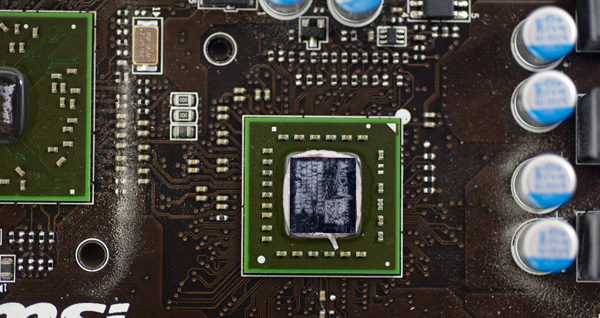
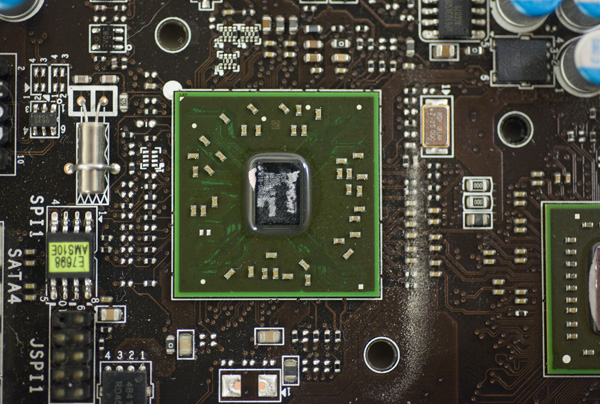
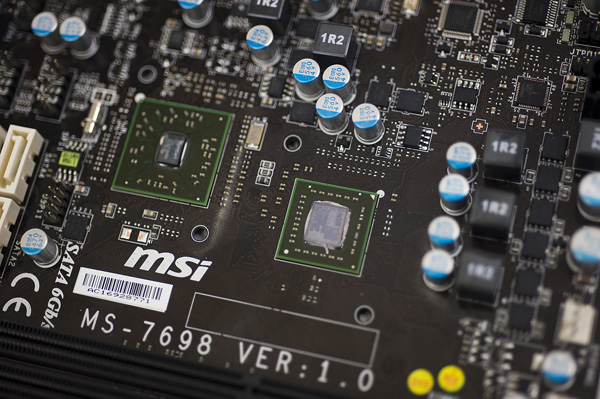
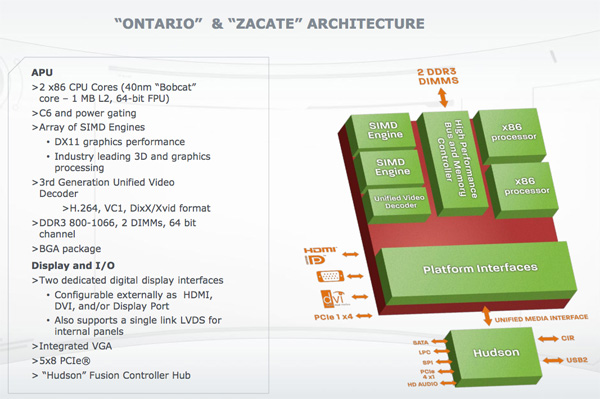








176 Comments
View All Comments
tno - Thursday, January 27, 2011 - link
http://www.anandtech.com/show/4017/vias-dual-core-...Not a full review but darn close.
e36Jeff - Thursday, January 27, 2011 - link
they did, its here:http://www.anandtech.com/show/4017/vias-dual-core-...
Problem is that what they tested was basically an engineering sample built on the wrong node, they havent gotten anything to market yet, so actual numbers from real products are unknown. having said that, yeah it does look like it might be better, but until someone makes a product based on it, we'll never know.
nitrousoxide - Thursday, January 27, 2011 - link
The price itself is stopping Nano X2 from dominating APU or Atom in the compete. The Nano platform consists of 3 different chips (aka CPU, NB, SB as the traditional layout) but the latter two managed to do that with only one chip, especially APU with very small die size. While Nano X2 is an impressive part compared to APU and Atom in absolute performance, it's not competitive in other features such as die size, price and power consumption.Tralalak - Friday, January 28, 2011 - link
AMD Zacate TDP Configs@18W + Hudson M1 = Fusion Controller Hub = ("South Bridge") TDP Configs@2,7W to 4,7 W for typical configurations === AMD Brazos 20,7W to 22,7W TDP. (2 chip solution)VIA say: VIA Nano X2 have some TDP than VIA Nano Single-Core.
VIA Nano X2 1.4GHz (40nm TSMC) have some TDP than VIA Nano U3200 1.4GHz (65nm Fujitsu) TDP = 6.5W
VIA Nano X2 1.4GHz max. TDP@6.5W + all-in-one chipset VIA VX900 MSP (Media System Processor = North Bridge (IGP) + South Bridge) max. TDP@4,5W === max.TDP@11W (2 chip solution)
I mean that In "minibotebook market" is very competitive.
VIA's 40nm next all-in-one chipset VIA VX MSP with DirectX 11 IGP refresh will appear in Q4 2011.
mczak - Monday, January 31, 2011 - link
VX900 has Chrome9 HC3 graphics core at 250Mhz - the same as VX800. Its 3d performance can barely keep up with the atoms anemic IGP (I could not find ANY review of VX900, just VX800), so totally no match for Brazos (though, in contrast to atom, it should support video decode much better). So your TDP comparison basically ignores the 3d part of it (surely the graphics core won't consume that much given its performance).Alright, even if I were to believe the DC Nano has same TDP as the current single core one, traditionally perf/power has never been that good with those VIA chips (not terrible, just not really good). Maybe their TDP definition is different (btw I've never seen a published TDP figure for any of the nano u3xxx series, which you seem to use as reference), also keep in mind runtime of notebooks is barely affected by TDP, much more important if you can get low idle power figures. I have no idea how the VIA platform would compete there (granted the publish idle power of the nano u3xxx cpus is only 100mW), but based on past designs I have to assume not very well (fwiw, this article here doesn't help for that neither, since the atoms don't have all of their mobile siblings power management features enabled).
So, unless VIA delivers, I remain sceptical if they can be competitive. Yes, a 1.4Ghz Nano DC should be quite competitive with 1.6Ghz Zacate performance wise - maybe also power wise, but 3d graphics will be very very sub par. To catch up in that area the new IGP is needed which as you mentioned is q4 (if the graphic core is like VN1000, it should do quite well, though I'll note that VN1000 plus the required southbridge has a 12W TDP).
bjacobson - Saturday, January 29, 2011 - link
I for one will be clicking any links with more info on these nanos! That sorely beat the Brazos out of nowhere hah!I doubt the it'll be much good at games though, and the drivers will be rough.,,
silverblue - Monday, January 31, 2011 - link
I've seen the Nano in comparison with Brazos before so I knew it was capable of being faster, however it'll take a load more power.The last time I saw a proper Nano rundown, we were talking a 65nm chip...
Iketh - Thursday, January 27, 2011 - link
power consumption is considerably higher on NanoAmdInside - Thursday, January 27, 2011 - link
Just curious if it was a fad or are people still buying Atom systems? I bought an Atom netbook but sold it within 30 days cause I couldn't stand it (Dell Mini 10v). Then I bought an ION Zotac Atom 330 system to use as a video streaming device for my bedroom and while I do like it for what it does, I just can't see myself buying another cheap lower powered Atom/AMD E-350 like device. I bought mine because the price made it seem like a great deal but once I got past that, I just lost interest in netbook/low powered mini-ITX platforms. Tablets on the other hand I am still hooked on. Love my iPad and may pick up a second this year and pass mine onto my wife.nitrousoxide - Thursday, January 27, 2011 - link
What APU/Atom can do is still far beyond ARM-based tablet's reach. Just look at how much superiority x86 have in absolute performance. E-350 has roughly 5 times the performance of Tegra 2, and even an Atom is significantly faster. So tablet is just an alternative of nettops, not a replacement. If you are fine with you iPad that's cool, but saying that nettop is dead is still far too early.The superiority of x86 is just unmatched by ARM, and that's why Intel claims that ARM is not a big deal for it. Want to be as fast? Then add more instructions sets, design more complicated architectures, and what you get is no longer an ARM.